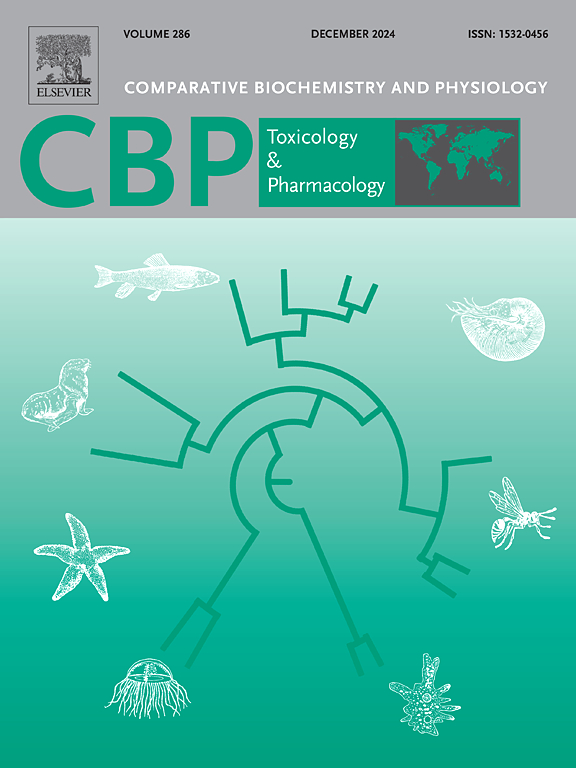Bisphenol AF induces lipid metabolism disorders, oxidative stress and upregulation of heat shock protein 70 in zebrafish
IF 3.9
3区 环境科学与生态学
Q2 BIOCHEMISTRY & MOLECULAR BIOLOGY
Comparative Biochemistry and Physiology C-toxicology & Pharmacology
Pub Date : 2025-02-26
DOI:10.1016/j.cbpc.2025.110164
引用次数: 0
Abstract
Bisphenol AF (BPAF) is a widespread endocrine disruptor in the environment, and the use of BPAF has been strongly associated with the development of several diseases. In this study, we investigated the effects of BPAF on growth, development, oxidative stress and lipid metabolism in zebrafish. We chose the concentrations based on the measured LC50 at 96 h post-fertilization (96 hpf), and the zebrafish embryos were exposed to three different concentrations (0.125, 0.5 and 2 μmol/L). The findings indicated that BPAF exposure in zebrafish leaded to alterations in heart rate, body length and hatching rate, as well as an accumulation of red blood cells in the heart. Additionally, BPAF exposure resulted in increased levels of neutrophils, reactive oxygen species (ROS) and malondialdehyde (MDA), and decreased activity of antioxidant enzymes (superoxide dismutase (SOD) and catalase (CAT)), thus disturbing the balance between oxidative and antioxidative systems. BPAF promoted fatty acid catabolism and inhibited fatty acid synthesis, ultimately leading to a reduction in fatty acid content. Mechanistically, RNA-seq analysis and RT-qPCR revealed a significant upregulation of heat shock protein 70 (hsp70) after BPAF exposure. Inhibition of hsp70 with VER-155008 ameliorated BPAF-induced oxidative stress. These data provided a novel approach to investigate BPAF-induced oxidative stress and suggested that regulation of hsp70 is a crucial target for alleviating this process.

双酚 AF 可诱导斑马鱼脂质代谢紊乱、氧化应激和热休克蛋白 70 的上调。
双酚AF (BPAF)是环境中广泛存在的内分泌干扰物,使用BPAF与多种疾病的发生密切相关。本研究研究了BPAF对斑马鱼生长发育、氧化应激和脂质代谢的影响。我们根据受精后96 h(96 hpf)测得的LC50来选择浓度,并将斑马鱼胚胎暴露于3种不同浓度(0.125、0.5和2 μmol/L)中。研究结果表明,接触BPAF会导致斑马鱼的心率、体长和孵化率发生变化,同时心脏中红细胞的积累也会增加。此外,BPAF暴露导致中性粒细胞、活性氧(ROS)和丙二醛(MDA)水平升高,抗氧化酶(超氧化物歧化酶(SOD)和过氧化氢酶(CAT))活性降低,从而扰乱了氧化和抗氧化作用之间的不平衡。BPAF促进脂肪酸分解代谢,抑制脂肪酸合成,最终导致脂肪酸含量降低。在机制上,RNA-seq分析和RT-qPCR显示BPAF暴露后热休克蛋白70 (hsp70)显著上调。VER-155008抑制hsp70可改善bpaf诱导的氧化应激。这些数据为研究bpaf诱导的氧化应激提供了一种新的方法,并表明调节hsp70是缓解这一过程的关键靶点。
本文章由计算机程序翻译,如有差异,请以英文原文为准。
求助全文
约1分钟内获得全文
求助全文
来源期刊
CiteScore
7.50
自引率
5.10%
发文量
206
审稿时长
30 days
期刊介绍:
Part C: Toxicology and Pharmacology. This journal is concerned with chemical and drug action at different levels of organization, biotransformation of xenobiotics, mechanisms of toxicity, including reactive oxygen species and carcinogenesis, endocrine disruptors, natural products chemistry, and signal transduction with a molecular approach to these fields.

 求助内容:
求助内容: 应助结果提醒方式:
应助结果提醒方式:


